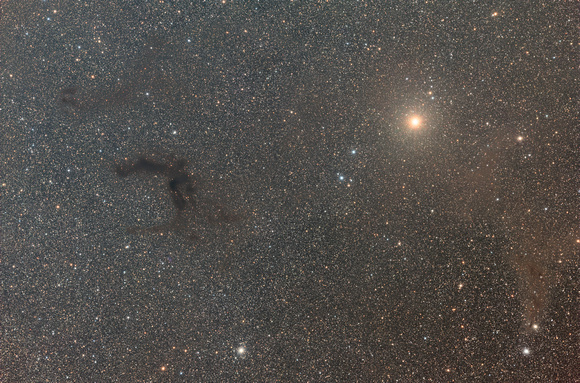Bardard's E (B142/B143) Defined by the Stars
Two Views of Barnard’s “E” (B142/B143) in LRGB – Ha
Teleview 127is; AP Mach2 GTO
ASI6200MM, - Baader RGB & 6.5nm NB CMOS opt. filters
R,G,B: (30,28,24 x 360s, Bin 1, Gain 0)
L: (32 x 300, Bin 1, Gain 0)
Ha: (35 x 720, Bin 1, Gain 100)
July 13,14,15,18 – 2023, Total integration time = 17.9 hrs
Barnard’s “E” lies within a rich starfield in the heart of the Milky Way in the constellation Aquila. Two dark nebula (molecular clouds) create the E shape primarily by dimming and even blotting out, the stars that lie behind it. This happens with many dark nebula as catalogued by Barnard, but in this instance, the shapes of the nebula combined with the rich starfield map out a typewritten “E” that is a favourite view with binoculars. The E is not perfect, as if insufficient ink was in the cosmic typewriter when the star field, that contains thousands of stars of virtually all magnitudes was struck. Fortunately, the molecular cloud that blocks the starlight (2,000 lys) is much closer than the stars.
Two views of Barnard’s “E” are presented here. The first is most akin to the view through an eyepiece/telescope or binoculars – it is the blotting out of the stars that defines the molecular cloud, although the “E” appears backwards/upside down in this image and is more colour saturation in the stars than one would likely “see”. In addition, if one looks closely at the image, one can see some reflection and colour actually coming from the molecular cloud as the starlight comes through it. However the presence of the dark nebulosity is primarily seen by it’s blocking of the starlight.
Three fairly recent advancements in astro processing have allowed us to get another view of the dark nebulosity. RC-Astro StarXterminator or Starnet allows us to take the stars out of the image and process the dim reflected light from the nebulosity separate from the overwhelmingly brighter stars. In this case, StarX not only targets the stars, but backfills – based on AI learning, what may exist behind the stars themselves. Once separated, GHS stretching (free software) allows us to bring out those dim reflections and bring them to the forefront of the image. Finaly star reduction techniques allow us, such as Blanshan/Cranfields star reduction scripts allow us to put the stars back into the image – but at a smaller scale to reduce their impact/presence on the final image.
The result is the second image, where the nebulosity is much more defined by its reflected light, rather than just by its opacity. It is interesting to me that much more can be revealed about dark nebulosity – not just by viewing it through sub- or super-visible frequency instruments, but also through modern processing techniques.
I should also point out, that due to an error in backfocus, I almost passed up this data for processing due to mis-shapened stars in the corners. RC-Astro’s latest BlurXterminator version (v2) and latest AI (v4) did a tremendous job of salvaging the data. Also, by search for emission data through the Ha filter was not fruitful and could have been dropped with little impact to the final image.


